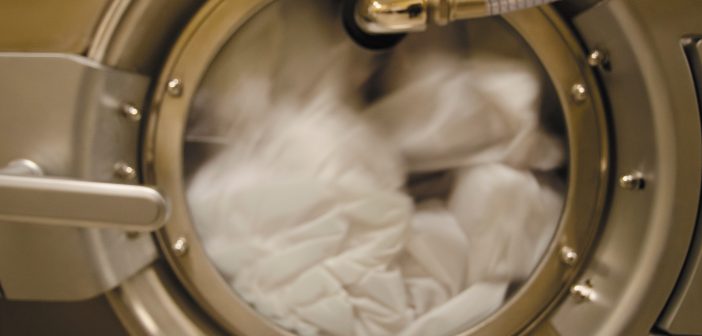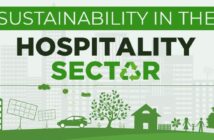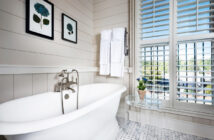Simple changes to existing process can have a substantial impact on costs.
by RANDY F. RADTKE
Occupancy sensors in rooms, CFL and LED lighting, and linen re-use programs are just a few of the ways properties in this industry are displaying their commitment to sustainability. Implementing a similar focus on sustainability in the laundry room can deliver equally significant savings. The trick is identifying where to focus your attention.Call it green. Call it sustainability. Call it environmentally conscious. Whatever you call it, it’s no longer just a trendy marketing term. Hotels and major hotel brands around the world are employing sustainability programs to not only conserve resources but, in the process, reduce operating costs.
“Many general managers are surprised at the quick returns that today’s new equipment can deliver. Payback on the investment often is less than a year,” said Mark Moore, owner of Versailles, Ky.-based REM Co., a leading distributor of UniMac laundry equipment. He added that even just simple process changes in the laundry can have significant impacts on operating costs.
A LOOK INSIDE THE NUMBERS
As we look at curbing costs and sustainability, it’s important to first have a baseline on costs. The average cost per pound to do laundry in-house is roughly 20 cents. It’s popular to think that outsourcing will bring cost savings, but contracting out for that service averages 40 to 50 cents per pound.
The main takeaway is that, while the laundry is a back-of-the-house expense, the quality it puts out impacts the front of the house (poorly finished sheets and towels definitely contribute to a substandard guest experience – and lower online reviews) and the profitability of the property.
It’s also imperative to understand that the largest cost to operating a laundry in-house is labor (roughly 50 percent), followed by linen replacement (20 percent), equipment (10 percent), utilities (9 percent), chemicals (8 percent), and maintenance (3 percent).
Exploring process changes and equipment updates can impact many of these areas and deliver additional cost savings, as well as an overall more sustainable approach to laundry.
Bill Brooks, North American sales manager for the UniMac brand of laundry equipment, pointed out that laundry management systems available to configure with some models of equipment are the first line in improving operating costs.
“Laundry managers have to establish what their laundry processing costs are, before they can begin improving on them,” Brooks said. “Without a tool to accurately monitor and report on operations, management is flying blind, with no view on where the process breakdowns and inefficiencies are.”

EFFICIENT WASHING
A thoughtful approach to the wash process can produce sustainable results in terms of labor, water/utility costs, linen replacement and chemicals.
Like items should be washed together and presorted according to soil levels. Washing like items reduces rejects, which saves water, time and chemicals. Another simple process change is making sure to wash full loads. Not only is it better for the washer-extractor but, again, it saves resources.
The national average for rejects is approximately 3 to 5 percent. If you are producing less than that, it’s likely you are using too many chemicals and, after three months or so, damage to those linens will become apparent.
“The foundation to clean laundry is time, temperature, machine action and chemistry,” Moore said. “Managers need to strike a perfect balance of these elements to maintain efficiency, clean results and the longest linen life. This is the core of sustainability in the laundry room.”
EFFICIENT DRYING
Efficiency on the drying side actually starts on the wash side with ultra-high (300 G-force) extraction, which removes significantly more water than low speed machines (100 G-force). How substantial? The difference between the two speeds for a 100-room hotel can be up to a $2,660 reduction in gas consumption for one tumbler per year, due to the reduced drying times.
Gas remains the most economical heat source for drying – roughly 80 cents for 100 pounds, versus $2 with electric heat, though Moore recommends switching tumblers to electric ignition, rather than a standing flame.
Moisture sensing technology also can reduce costs and conserve resources by drying to a preset moisture level and then shutting off the tumble dryer. This feature eliminates over-drying, which wastes time and gas, and contributes to linens wearing out faster.
A property processing 10 loads per day would save about $883 in utilities and $4,866 in labor each year if it eliminated just eight minutes of over-drying. Just eight minutes of over-drying can reduce linen life by 33 percent.
“Make no mistake, over-drying of linens is an all-too-frequent occurrence in the hospitality market,” Moore said. “Moisture sensing technology is definitely an area where the return on the investment in new equipment can quickly add up and pay for the upfront machine cost – and that’s not even factoring in the longer linen life.”
Other process improvements that may help curb costs can include utilizing delayed start capabilities built into some wash programs. This enables staff to load the washer before leaving for the night and set it to start before the morning shift arrives. Staggering shift start times will help maximize labor efficiency.
Moore also suggests scheduling shifts at night, during off-peak hours to reduce gas costs.
FINAL THOUGHTS
Hotel properties don’t just back their way into sustainable business practices in the laundry. A good first step is meeting with an equipment distributor with experience in the hospitality market. The best in the business will be able to perform a laundry analysis to identify any inefficiencies.
“Having a roadmap to efficiency is a start, but once a laundry goes through an upgrade, laundry management systems are necessary to ensure processes are being followed,” Brooks said. “Management must stay plugged into sustainability through constant review of metrics. Laundry management systems such as UniMac’s TotalVue can help ensure maximum efficiency and even compare properties to identify which ones are performing and which ones need help.” ■




